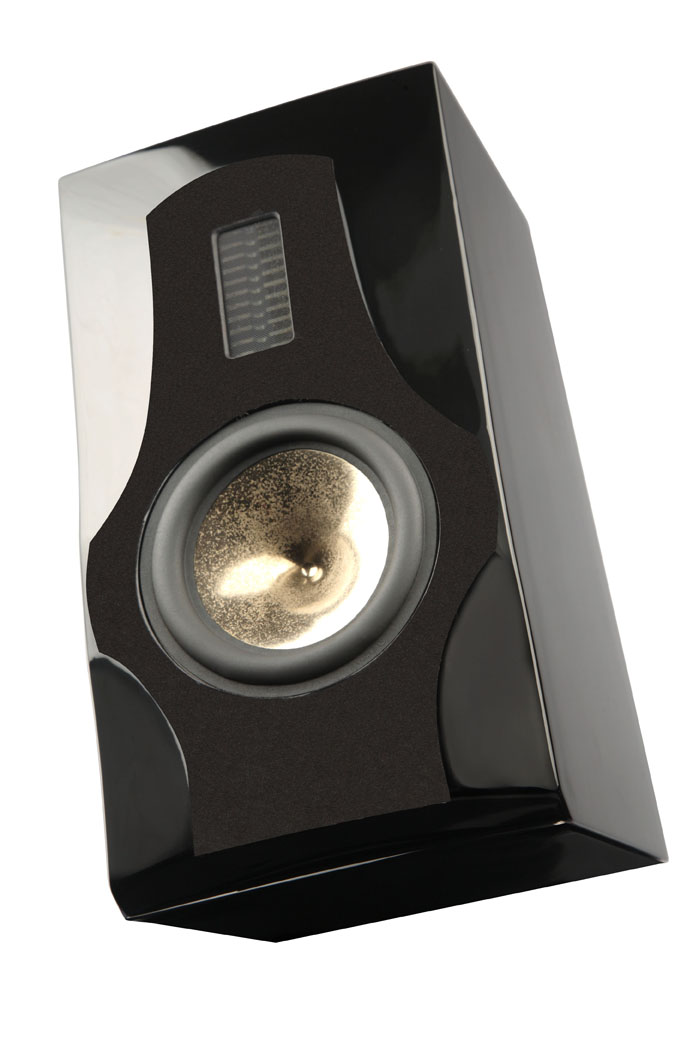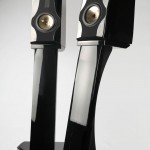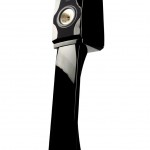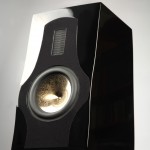Admonitor Premiere
The ideal transducer would be a “reversed microphone”… in other words; you use for reproduction a small point-source full-range transducer that mimics the characteristics of the microphone used for the recording.
However such an ideal transducer is simply unattainable. Even considering hypothetical perfect frequency extension, the unit would need to be at the same time very small; for ideal high frequency dispersion, and have significant radiating area; for credible low frequency reproduction .
Furthermore, work with many of the full-range loudspeakers available in a typical size of 5″- 8″, we also have to suffer of these necessary compromises: – restricted top-end dispersion. – compromised low-frequency performance. – compromised centre spectral performance; due to excessive optimisation of the low and high frequency reach. By transforming the point-source requirement above into a line-source system, we can use a multitude of smaller full-range units in a row to obtain a “line array”. Helping to satisfy the contradictory requirement of small and large dimensions at the same time. Smaller full-range units certainly tend have much more acceptable high-frequency extension. In professional audio, such large scale “line arrays” are extremely popular in auditoria and concerts. In these professional applications specific care of the radiation pattern needs to be taken care of, for correct audience coverage. The individual “modules” are amplitude, time and frequency steered.
In the domestic listening conditions, to be often considered near-field, the theoretical “cylindrical” full-range line-source radiation pattern is not too ideal ; the amplitude/frequency/time control of the vertical array is absolutely necessary. This brings us back to the Admonitor Première/Submonitor MkIII solution. This AP/S system was designed as a distributed source array, as one possible solution for a “reverse-microphone” application loudspeaker .
Taken in isolation, the Admonitor Première is the simplest “practical” implementation for the “reverse-microphone”. The conflicting requirements for high frequency dispersion and low frequency extension have been resolved by using a 2 unit array with distributed higher and lower frequency spectrums.
The small dimensions and proximity of the drivers allow for a near point-source performance, even at very short distances (>1.5 m ) . Furthermore, the small dimensions of the cabinets, comparable to those of the human head, reduce listening fatigue, due to the “familiar” time/space behaviour of diffraction.
The main points of the Admonitor Première are: – Point-source hypo-cardioid radiation (small FAST tweeter with low crossover point to a small 130 mm woofer). – “T20Z” crossover technology, for stable minimum interference radiation of the dual point-source array. – ZSS 32 ( Ariacell GTi ) technology for highest definition and information retrieval. – FAST Heil type tweeter. – “DXD” ready monitoring quality. The Submonitor MKIII is the lower element of the array. This allows more accurate low frequency extension and headroom. The Submonitor was designed to be integrated with the Admonitor Première . Visual impact has been optimised by the use of 3 pieces 165m drivers .
Low frequency extension is the result of the EAARR ” Enhanced Active Auxilary Radiator Reflex” loading system. The Submonitor is seamlessly integrated in the Admonitor Première by the mutational “Transfer20Z” crossover technology.
Technological aspects
The crossover for the head is a further evolution of the “Transfert 0” solution , that we call “T20Z” , i.e. T Square Zero “Z” ( Transitional Transfert 0 Z ) . We have taken care of the back-EMF of the tweeter , by optimising the look-back impedance of the filter . Also , the null in the high-pass allows the unit to be totally inhibited at it’s resonant frequency , by practically not recieving any excitation in this area .
Of course , all highest quality crossover components have been kept ( Mundorf Silver/Gold and Supreme capacitors and air core coils ) . The “T20 Z” structure through the “Z” type topology of the circuit , having components both in the “hot” and the “cold” connections to the driver , allows a further increase of definition and transparency of the reproduction. Psycho-acoustically , the crossover is optimised to take care of the “Pinna” effect , which is a further sonic improvement ( extremely important specially for center channel applications ). The 5” main “vocal” unit is the latest expression of the Ariacell GTi technology ; the Z32. Z3 , as previously described , uses a syntactic foam of aerospace derivation , formulated in such a way as to have a different density along the depth on the cone ( smaller cells near the outer skins and bigger ones at the centre of the core ).
This cellular nature of the cone , allows the high percentage of air as the main material in the cone . Also the very special skins are state-of-the-art for this application , consisting of nano-graphite fibres in a 3D alea structure matrix ( Hypergraph ) , strengthened with vacuum/plasma Titanium surfaces .
The 3D alea structure matrix of the high quality carbon fibres ( graphite fibre ) , is also vastly superior to traditional textile/woven structures , the fibres go in every 3D direction in a random way ( not in a simple weave and are 10 times lighter ) , and have the ability, due to better transformation of kinetic energy into heat , to damp spurious resonances. The ultra-thin Plasma/vacuum Titanium external skin allows a very high speed of surface wave propagation and contribute to this very clear and transparent sound . However , the real secret ingredient of our cones is ; air . In fact most of the cone , due to it’s cellular nature , is made of air . Of course , this unit has a multi-element high acceleration factor , low compression , motor. The F.A.S.T. acronym is for “Folded Aero Striction Transducer” ( or “Folded Air Squeezing Transducer )” . It is our implementation of the tweeter typology originally invented by Prof. Oskar Heil. The need for a very fast transient response and at the same time the ability to reproduce important dynamic excursions , has led us towards the path of the “air squeezing” solution , invented by this brilliant German physicist. The air motion is transformed with a ratio of 5 to 1 , allowing full dynamics at the very critical ( low ) crossover frequency. The FAST , compared to previous “air motion transformer” iterations , has a totally “stealthy” sonic character , thanks to a special “mute elastomer” based membrane ( avoiding any colouration ) and to a very “open” magnetic system. Transparency , resolution , micro and macro dynamics are there , while hardness is absent . The “non-interference” between the high and the low frequency driver is one of our main concerns , see our “T20” crossover . While crossovers can keep out electrically unwanted bandwidth signals from the relative driver on the input to the latter , they have for the same reason difficulty in “sinking” signals ( look-back impedance ) coming from the tweeter , due to back-emf ; “T20Z” addresses this issue. Since tweeters usually are rather good microphones/accelerometers ( in fact , in the past microphones have been used as super-tweeters , like the STC unit used on the Spendor BC1 ) , they can pick up the vibrations generated by the woofer and “store” them ( due again to the look-back characteristics of the high-pass crossover ) , creating anomalies in the transient decay. In this sense , our version of the Heil tweeter has 3 major advantages :
1) It is a very inefficient microphone , compared to other tweeters.
2) The sound generating motion of the tweeter diaphragm is orthogonal to the motion of the woofer diaphragm, greatly reducing possible woofer-to-tweeter intermodulation.
3) The very soft “mute elastomer” membrane further represents a mechanical filter .
Specifications
The Admonitor Première has been designed to match the challenge of state-of-the-art DXD mastered multichannel musical recordings. The design characteristics are ; the special resistive reflex tuning ; the decent sensitivity ; the superbly transparent and fast midrange from the hand-built drivers ; the extended listening zone, maintaining ultra-precise three-dimensional imaging ; the superior integration and balance of sound from top to bottom ; the delicacy and resolution of the treble thanks to the custom made FAST tweeter.
The Admonitor Première is not extremely power hungry , however it needs very high quality amplification in the 25W to 100 W league. Good care is needed in setting up correctly the speakers in the listening room , to get maximum results By extending the low frequency reach with the Submonitor MkIII module , the systems becomes a true reference system , with the authority of full-scale music reproduction.
System: 2 way moving-coil hypocardioid compact minimonitor, air-flow controled vent.
Drivers: FAST tweeter and 130 mm Ariacell GTi sandwich midwoofer ( Z32 ).
Crossover : Multislope Elliptical, “Transitional Transfert 0 Z”
type ( “T20Z” ) implemented with high grade components.
Impedance : Nominal 4-8 Ohm, non-critical
Sensitivity : 87db/2.83V/m
Rec. Amplifier Power : 25 to 100 W
Frequency Range : 39Hz to 21Khz
Maximum Sound Level : 103 dbA
Cabinet : Profiled , sloped , high-density polymer sandwich
Finish : High Gloss Piano Polyester
Dimensions : 350 mm high , 185 mm wide , 280 mm deep




